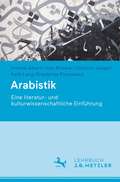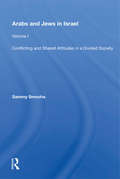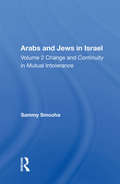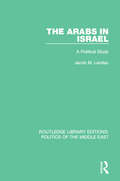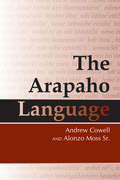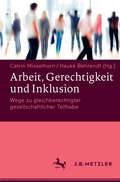- Table View
- List View
Arabien: Mehr als Erdöl und Konflikte (Politisches Streiflicht)
by Udo SteinbachDie Araber und die "Arabische Welt" begegnen uns nahezu täglich - in ganz unterschiedlichen Zusammenhängen - in den Medien. Gegenstand und Anlaß der Berichterstattung freilich sind zumeist wenig erfreulich. Das hat viele Gründe. Einer ist in der Tht das schwere Erbe, das die Geschichte den Arabern hinterlassen hat: erst die Herrschaft des Os manischen Reiches, später die anderthalb Jahrhunderte dauernde Dominanz Europas. Ein anderer Grund liegt naturgemäß in den Ara bern selbst. Vergleichen mit anderen Teilen der nicht-europäischen (im weitesten Sinne) Welt tun sie sich schwer, die Gegebenheiten und Erfordernisse der Modeme anzunehmen und mitzugestalten. Ein dritter Grund aber liegt in unserem eingeschränkten Wahrneh mungsvermögen in einer Zeit, in der vornehmlich negative Sensatio nen, vermittelt in den Medien, eine breite Öffentlichkeit unter halten. In unseren Thgen, in der die Welt so rasch zusammenwächst, in der Schranken fallen und neue Formen vielseitiger Zusammenarbeit ent stehen, sollten wir uns eine solche Fremdheit nicht mehr leisten. Das hier vorgelegte Bändchen soll deshalb ein wirklichkeitsnahes Bild der Araber und ihrer "Welt" vermitteln. Es soll helfen, Fremdheit zu überwinden. Nach der Durchsicht der zumeist kurzen Beiträge soll der Leser das Gefühl haben, etwas mehr von der "arabischen Welt", ihren Menschen und Problemen, aber auch ihren Bemühungen, in dieser Welt einen Platz zu finden, zu verstehen, als dies ihm aus der laufenden Berichterstattung möglich ist.
Arabisch-Amerikanische Jugend: Diskriminierung, Entwicklung, Bildungspraxis und -politik
by Rhonda TabbahDieses Buch untersucht die Auswirkungen der Diskriminierung arabisch-amerikanischer Jugendlicher mit Schwerpunkt auf den K-12-Schulsystemen. Es beginnt mit einer Einführung in die arabisch-amerikanische Jugend und ihre Erfahrungen im Bildungssystem. Es folgt ein Überblick über die historischen Beiträge zur Diskriminierung und die Geschichte der Diskriminierung von Arabern in Amerika, einschließlich des Bildungssystems. Anschließend werden relevante theoretische Perspektiven zu Diskriminierung und Entwicklungsprozessen vorgestellt. Das Buch untersucht Forschungsergebnisse, die sich speziell auf arabisch-amerikanische Jugendliche beziehen, zeigt die Grenzen der Forschung auf und bietet Strategien zur Stärkung der methodischen Ansätze, um Forschung, Praxis und Politik besser zu informieren. Abschließend werden Strategien zur Verbesserung der Bildungspraxis und -politik sowie Empfehlungen für Interventionen zur Förderung der Entwicklungsgesundheit arabisch-amerikanischer Jugendlicher in Schulen gegeben.Zu den wichtigsten Themenbereichen gehören:· Arabisch-amerikanische Jugend, Entwicklung und Diskriminierung in Amerika.· Diskriminierung im K-12-Bildungssystem.· Selbstkonzept, ethnische Identität, Wohlbefinden und Diskriminierung unter arabisch-amerikanischen Jugendlichen.Arab American Youth ist ein unverzichtbares Hilfsmittel für Praktiker, Forscher, Pädagogen und andere Fachleute sowie für Studenten der Schulpsychologie, der pädagogischen Psychologie, der Pädagogik und verwandter Disziplinen.Dr. Tabbah hat ein Buch geschrieben, das längst überfällig ist ... Sie liefert einen Entwurf für Fortschritte im Bildungswesen und in der politischen Entwicklung, die für die arabisch-amerikanische Jugend von Bedeutung sein können.Antoinette Miranda, Professorin für Schulpsychologie, The Ohio State UniversityDieses Buch ist ein wertvoller Beitrag angesichts der erst im Entstehen begriffenen Literatur über die Erfahrungen arabischer Jugendlicher und die erheblichen Auswirkungen von Diskriminierung auf ihre Schulbildung.Desiree Vega, Außerordentliche Professorin für Schulpsychologie, Universität von Arizona
Arabischer Frühling?: Alte und neue Geschlechterpolitiken in einer Region im Umbruch (Feministisches Forum #5)
by Dagmar Filter Jana Reich Eva FuchsDer Band befasst sich mit der Frage nach der politischen und gesellschaftlichen Partizipation von Frauen und Männern in muslimischen Gesellschaften vor, während und nach dem Arabischen Frühling, sowie der Bedeutung von Geschlechter(de)konstruktionen in einer Gesellschaft im Wandel.In den meisten Ländern des "Arabischen Frühlings" sind die Geschlechterverhältnisse durch eine patriarchale Struktur und Tradition geprägt, die besonders Frauen in ihrer persönlichen Freiheit und in ihrer politischen Mitbestimmung einschränkt. Die revolutionären Prozesse in diesen Gesellschaften bieten die Chance, die Geschlechterverhältnisse aufzubrechen, neu zu denken und zu verhandeln. Die Selbstbefreiung der arabischen Frauen kann nicht automatisch durch die aktuellen revolutionären Veränderungen gelingen. Dennoch wohnt Revolutionen ein utopisches Potential inne, das durch keine konterrevolutionären Maßnahmen aufgehalten werden kann. Zwischen revolutionärer Wirklichkeit und inspirierter Utopie geht der Kampf um die Selbstbefreiung der Frauen (und der Männer) in der arabischen Welt weiter.
The Arab–Israeli Conflict, 1956–1975: From Violent Conflict to a Peace Process (Israeli History, Politics and Society)
by Moshe GatThe Arab–Israeli Conflict, 1956–1975 contains a collection of articles that examine select issues between the end of the Suez Campaign in November 1956 and the Sinai II, or Interim Agreement, signed by Israel and Egypt in September 1975. The book provides a comprehensive overview of the struggle between the three superpowers – the UK, the United States and the Soviet Union – and the effects this had on the region. It also explores the circumstances that led to the Six Day War in June 1967, such as the use of air power and the Israeli retaliatory raids. Two chapters look at the two leaders during the war: Egyptian President Gamal Abdel Nasser, leader of the Arab world – a charismatic and dominant persona – and Israeli Prime Minister Levi Eshkol, considered weak and inconspicuous. Three chapters focus on the period between the two wars – June 1967 and October 1973 – and one explores the aftermath. Emphasis is placed on Israeli policy between 1967 and 1973, which primarily focused on the use of military power and foreign policy inaction. It is argued that it was this policy that hindered all progress in the peace process, and ultimately led, among other factors, to the Yom Kippur War. The final chapter is on Kissinger and the road to the Sinai II Agreement. It discusses the huge shift in American policy – from avoiding a significant role in the prevention of an imminent war during May and June of 1967, to deep involvement in every detail of the dispute during and following the Yom Kippur War. Providing an in-depth examination of this important period of the Arab–Israeli conflict, this book will appeal to students and scholars of Middle Eastern History and Politics, Conflict Studies and International Relations.
The Arab–Israeli Conflict, 1956–1975: From Violent Conflict to a Peace Process (Israeli History, Politics and Society)
by Moshe GatThe Arab–Israeli Conflict, 1956–1975 contains a collection of articles that examine select issues between the end of the Suez Campaign in November 1956 and the Sinai II, or Interim Agreement, signed by Israel and Egypt in September 1975. The book provides a comprehensive overview of the struggle between the three superpowers – the UK, the United States and the Soviet Union – and the effects this had on the region. It also explores the circumstances that led to the Six Day War in June 1967, such as the use of air power and the Israeli retaliatory raids. Two chapters look at the two leaders during the war: Egyptian President Gamal Abdel Nasser, leader of the Arab world – a charismatic and dominant persona – and Israeli Prime Minister Levi Eshkol, considered weak and inconspicuous. Three chapters focus on the period between the two wars – June 1967 and October 1973 – and one explores the aftermath. Emphasis is placed on Israeli policy between 1967 and 1973, which primarily focused on the use of military power and foreign policy inaction. It is argued that it was this policy that hindered all progress in the peace process, and ultimately led, among other factors, to the Yom Kippur War. The final chapter is on Kissinger and the road to the Sinai II Agreement. It discusses the huge shift in American policy – from avoiding a significant role in the prevention of an imminent war during May and June of 1967, to deep involvement in every detail of the dispute during and following the Yom Kippur War. Providing an in-depth examination of this important period of the Arab–Israeli conflict, this book will appeal to students and scholars of Middle Eastern History and Politics, Conflict Studies and International Relations.
Arabistik: Eine literatur- und kulturwissenschaftliche Einführung
by Yvonne Albers Ines Braune Christian Junge Felix Lang Friederike PannewickDie Umbrüche in der arabischen Welt seit Beginn des Arabischen Frühlings verlangen Veränderungen in der arabistischen Forschung und Lehre. Diese Einführung plädiert für eine Öffnung des Faches für kultur- und sozialwissenschaftliche Fragestellungen und konzentriert sich auf Moderne und Gegenwart (19.–21. Jh.). Der Band stellt die wichtigsten künstlerischen Ausdrucksformen vor: Literatur, Theater, Kunst, Musik und Film. Der Analyse dieser Kunstformen als soziale und kulturelle Praxis ist ein eigenes Kapitel gewidmet. Ein weiterer Teil beschreibt verschiedene Konzepte wie Geschlecht, postkoloniale Identität und Raum. Zudem vermittelt der Band interdisziplinäre Methoden, wie Interviewführung, Feldforschung und betont die Problematisierung der eigenen wissenschaftlichen (Macht-)Position für die Forschungs- und Lehrpraxis einer zeitgemäßen Arabistik.
Arabs and Iranians in the Islamic Conquest Narrative: Memory and Identity Construction in Islamic Historiography, 750–1050 (Culture and Civilization in the Middle East)
by Scott SavranArabs and Iranians in the Islamic Conquest Narrative analyzes how early Muslim historians merged the pre-Islamic histories of the Arab and Iranian peoples into a didactic narrative culminating with the Arab conquest of Iran. This book provides an in-depth examination of Islamic historical accounts of the encounters between representatives of these two peoples that took place in the centuries prior to the coming of Islam. By doing this, it uncovers anachronistic projections of dynamic identity and political discourses within the contemporaneous Islamic world. It shows how the formulaic placement of such embellishment within the context of the narrative served to justify the Arabs’ rise to power, whilst also explaining the fall of the Iranian Sasanian empire. The objective of this book is not simply to mine Islamic historical chronicles for the factual data they contain about the pre-Islamic period, but rather to understand how the authors of these works thought about this era. By investigating the intersection between early Islamic memory, identity construction, and power discourses, this book will benefit researchers and students of Islamic history and literature and Middle Eastern Studies.
Arabs and Iranians in the Islamic Conquest Narrative: Memory and Identity Construction in Islamic Historiography, 750–1050 (Culture and Civilization in the Middle East)
by Scott SavranArabs and Iranians in the Islamic Conquest Narrative analyzes how early Muslim historians merged the pre-Islamic histories of the Arab and Iranian peoples into a didactic narrative culminating with the Arab conquest of Iran. This book provides an in-depth examination of Islamic historical accounts of the encounters between representatives of these two peoples that took place in the centuries prior to the coming of Islam. By doing this, it uncovers anachronistic projections of dynamic identity and political discourses within the contemporaneous Islamic world. It shows how the formulaic placement of such embellishment within the context of the narrative served to justify the Arabs’ rise to power, whilst also explaining the fall of the Iranian Sasanian empire. The objective of this book is not simply to mine Islamic historical chronicles for the factual data they contain about the pre-Islamic period, but rather to understand how the authors of these works thought about this era. By investigating the intersection between early Islamic memory, identity construction, and power discourses, this book will benefit researchers and students of Islamic history and literature and Middle Eastern Studies.
Arabs And Jews In Israel: Volume 1, Conflicting And Shared Attitudes In A Divided Society
by Sammy SmoohaOn December 9, 1987, the Palestinians on the West Bank and Gaza Strip launched the most serious challenge in this century to non-Arab rule in the area West of the Jordan river. A genuine grassroots movement against protracted occupation and for self-determination, the Intifadeh has already inflicted many losses and scored many gains. By the first anniversary of the uprising, the toll for the revolting Palestinians was at least 280 dead, 4,000 wounded, 5,500 detainees, and some deportations and house demolitions. The substantial suffering and privations also entailed numerous beatings, curfews, arrests, searches, cuts in basic services, closings of schools, and losses of income. The Israelis have had 10 killed, 1,150 wounded, a minimum of a 1.5% drop in the Gross National Product, the stress of a people's,army fighting civilians of an occupied nation, increased international isolation and censure, and the straining of relations with the Diaspora.
Arabs And Jews In Israel: Volume 1, Conflicting And Shared Attitudes In A Divided Society
by Sammy SmoohaOn December 9, 1987, the Palestinians on the West Bank and Gaza Strip launched the most serious challenge in this century to non-Arab rule in the area West of the Jordan river. A genuine grassroots movement against protracted occupation and for self-determination, the Intifadeh has already inflicted many losses and scored many gains. By the first anniversary of the uprising, the toll for the revolting Palestinians was at least 280 dead, 4,000 wounded, 5,500 detainees, and some deportations and house demolitions. The substantial suffering and privations also entailed numerous beatings, curfews, arrests, searches, cuts in basic services, closings of schools, and losses of income. The Israelis have had 10 killed, 1,150 wounded, a minimum of a 1.5% drop in the Gross National Product, the stress of a people's,army fighting civilians of an occupied nation, increased international isolation and censure, and the straining of relations with the Diaspora.
Arabs And Jews In Israel/two Volume Set: Volume 1, Conflicting And Shared Attitudes In A Divided Society
by Sammy SmoohaIn this treatment of the problem of Arab-Jewish coexistence in Israel, which furnishes data on the news of Israel's divided population, Dr. Smooha challenges the gloomy perspective that impediments to peaceful relations between Israel's Jewish majority and Arab minority will inevitably lead to ever more violent confrontation. He asserts instead tha
Arabs And Jews In Israel/two Volume Set
by Sammy SmoohaIn this treatment of the problem of Arab-Jewish coexistence in Israel, which furnishes data on the news of Israel's divided population, Dr. Smooha challenges the gloomy perspective that impediments to peaceful relations between Israel's Jewish majority and Arab minority will inevitably lead to ever more violent confrontation. He asserts instead tha
The Arabs and the West (Routledge Library Editions: Politics of the Middle East)
by Clare HollingworthThis volume by acclaimed war reporter Clare Hollingworth , first published in 1952, surveys the politics of an area which has produced, and is likely to produce, more wars that it can consume locally. After a historical opening, about the general situation during and after the war, the author devotes chapters to the different States, and writes in some detail of the main problems affecting the area, such as oil, military power, communism and industrialization.
The Arabs and the West (Routledge Library Editions: Politics of the Middle East)
by Clare HollingworthThis volume by acclaimed war reporter Clare Hollingworth , first published in 1952, surveys the politics of an area which has produced, and is likely to produce, more wars that it can consume locally. After a historical opening, about the general situation during and after the war, the author devotes chapters to the different States, and writes in some detail of the main problems affecting the area, such as oil, military power, communism and industrialization.
The Arabs in Israel: A Political Study (Routledge Library Editions: Politics of the Middle East)
by Jacob M. LandauThis book, first published in 1969, presents a comprehensive survey and analysis of the political behaviour of the Arabs in Israel, covering the period from the founding of the State to the Six-Day War in 1967. While the socio-economic background is outlined, the chief emphasis is on the political attitudes of this minority and its reactions to the modernization of political structures. The main chapters deal with adaptation versus alienation; cultural change and its reflection in politics; political organizations; voting behaviour in parliamentary, local, and trade union elections; leadership and the foci of political activity. Materials used for research included the Israeli press, both in Arabic and Hebrew, the literature produced by the Arabs in Israel, official publications and private reports, as well as interviews conducted with Arabs from all over the country.
The Arabs in Israel: A Political Study (Routledge Library Editions: Politics of the Middle East)
by Jacob M. LandauThis book, first published in 1969, presents a comprehensive survey and analysis of the political behaviour of the Arabs in Israel, covering the period from the founding of the State to the Six-Day War in 1967. While the socio-economic background is outlined, the chief emphasis is on the political attitudes of this minority and its reactions to the modernization of political structures. The main chapters deal with adaptation versus alienation; cultural change and its reflection in politics; political organizations; voting behaviour in parliamentary, local, and trade union elections; leadership and the foci of political activity. Materials used for research included the Israeli press, both in Arabic and Hebrew, the literature produced by the Arabs in Israel, official publications and private reports, as well as interviews conducted with Arabs from all over the country.
The Arapaho Language: Language And Power Among The Northern Arapaho
by Andrew Cowell Alonzo Moss, Sr.The Arapaho Language is the definitive reference grammar of an endangered Algonquian language. Arapaho differs strikingly from other Algonquian languages, making it particularly relevant to the study of historical linguistics and the evolution of grammar. Andrew Cowell and Alonzo Moss Sr. document Arapaho's interesting features, including a pitch-based accent system with no exact Algonquian parallels, radical innovations in the verb system, and complex contrasts between affirmative and non-affirmative statements. Cowell and Moss detail strategies used by speakers of this highly polysynthetic language to form complex words and illustrate how word formation interacts with information structure. They discuss word order and discourse-level features, treat the special features of formal discourse style and traditional narratives, and list gender-specific particles, which are widely used in conversation. Appendices include full sets of inflections for a variety of verbs. Arapaho is spoken primarily in Wyoming, with a few speakers in Oklahoma. The corpus used in The Arapaho Language spans more than a century of documentation, including multiple speakers from Wyoming and Oklahoma, with emphasis on recent recordings from Wyoming. The book cites approximately 2,000 language examples drawn largely from natural discourse - either recorded spoken language or texts written by native speakers. With The Arapaho Language, Cowell and Moss have produced a comprehensive document of a language that, in its departures from its nearest linguistic neighbors, sheds light on the evolution of grammar.
Ararat in America: Armenian American Culture and Politics in the Twentieth Century (Armenians in the Modern and Early Modern World)
by Benjamin F. AlexanderHow has the distinctive Armenian-American community expressed its identity as an ethnic minority while 'assimilating' to life in the United States? This book examines the role of community leaders and influencers, including clergy, youth organizers, and partisan newspaper editors, in fostering not only a sense of Armenian identity but specific ethnic-partisan leanings within the group's population. Against the backdrop of key geopolitical events from the aftermath of the Armenian Genocide to the creation of an independent and then Soviet Armenia, it explores the rivalry between two major Armenian political parties, the Tashnags and the Ramgavars, and the relationship that existed between partisan leaders and their broader constituency. Rather than treating the partisan conflict as simply an impediment to Armenian unity, Benjamin Alexander examines the functional if accidental role that it played in keeping certain community institutions alive. He further analyses the two camps as representing two conflicting visions of how to be an ethnic group, drawing a comparison between the sociology-of-religion models of comfort religion and challenge religion. A detailed political and social history, this book integrates the Armenian experience into the broader and more familiar narratives of World War I, World War II, and the Cold War in the USA.
Ararat in America: Armenian American Culture and Politics in the Twentieth Century (Armenians in the Modern and Early Modern World)
by Benjamin F. AlexanderHow has the distinctive Armenian-American community expressed its identity as an ethnic minority while 'assimilating' to life in the United States? This book examines the role of community leaders and influencers, including clergy, youth organizers, and partisan newspaper editors, in fostering not only a sense of Armenian identity but specific ethnic-partisan leanings within the group's population. Against the backdrop of key geopolitical events from the aftermath of the Armenian Genocide to the creation of an independent and then Soviet Armenia, it explores the rivalry between two major Armenian political parties, the Tashnags and the Ramgavars, and the relationship that existed between partisan leaders and their broader constituency. Rather than treating the partisan conflict as simply an impediment to Armenian unity, Benjamin Alexander examines the functional if accidental role that it played in keeping certain community institutions alive. He further analyses the two camps as representing two conflicting visions of how to be an ethnic group, drawing a comparison between the sociology-of-religion models of comfort religion and challenge religion. A detailed political and social history, this book integrates the Armenian experience into the broader and more familiar narratives of World War I, World War II, and the Cold War in the USA.
Arbeit — Freizeit — Lebenszeit: Grundlagenforschungen zu Übergängen im Lebenszyklus
by Franz RosenmayrDie hier vorgelegten Ergebnisse stellen im wesentlichen folgende Zusam menhänge klar: Mit steigendem Alter steigen bis zur Altersgruppe der 40-50jährigen sowohl die Gesamtzahl der angegebenen beruflichen Belastungen, als auch die der chronischen Erkrankungen. Bei den höheren Altersgruppen nimmt die Gesamtzahl der angegebenen Belastungen ab, die Anzahl der chronischen Erkrankungen steigt hingegen mit steigendem Alter weiter an. Der scheinbare Rückgang beruflicher Beanspruchungen in der Alters gruppe der über 60jährigen ist erklärungsbedürftig. Als wahrscheinlichste Erklärung scheint uns ein Selektionsprozeß wirksam zu sein. Eine weitere denkbare Erklärung wäre größere Resistenz der älteren Arbeitnehmer gegen über Belastungen. Gegen eine solche Erklärung sprechen allerdings nicht nur unsere Daten, die es unwahrscheinlich erscheinen lassen, daß die Sensibilität bis zum Alter von etwa 50 ansteigt und dann wieder geringer wird, sondern auch die zitierten arbeitswissenschaftlichen Erfahrungen, die dafür sprechen, daß eine Tendenz besteht, ältere Arbeitnehmer auf eher weniger belastete Arbeitsplätze zu versetzen. Wir halten also die Erklärung eines Selektionsef fektes für die wahrscheinlichere. Der Zusammenhang zwischen chronischen Erkrankungen und beruflichen Belastungen ist deutlich erkennbar. Befragte mit einer höheren Anzahl an perzipierten beruflichen Belastungen haben eine höhere Anzahl chronischer Erkrankungen als solche mit einer niedrigen Anzahl beruflicher Belastungen.
Arbeit, Arbeitsmarkt und Betriebe (Berichte der Kommission für die Erforschung des Sozialen und Politischen Wandels in den Neuen Bundesländern e.V.: (KSPW) #1)
by Burkart Lutz Hildegard M. Nickel Rudi Schmidt Arndt SorgeBurkart Lutz 1. Schwächen und Verkürzungen der frühen Transformationsforschung Die tiefgreifenden Veränderungen in den wirtschaftlichen und politischen Verhältnissen Ostdeutschlands und in den Lebensbedingungen und Lebens chancen der ostdeutschen Bevölkerung, die im Gefolge der deutschen Einheit vonstatten gingen, lösten - unterstützt durch eine größere Zahl von Förder programmen - einen regelrechten Boom an Untersuchungen aus, für die sich sehr schnell der Oberbegriff der "Transformationsforschung" durchsetzte. Ih ren Fragestellungen und den Analysen und Interpretationen der Veröffentli chungen, die aus ihnen hervorgingen, lag nahezu durchgängig eine Argumen tationsfigur zugrunde, die weit über die Wissenschaft hinaus die öffentliche Diskussion bestimmte und die man geradezu als Paradigma der frühen Trans formationsforschung bezeichnen kann. Sie läßt sich ohne unzulässige Verein fachung in zwei Thesen zusammenfassen: 1. Der rasche Transfer der westdeutschen Institutionen in die ostdeutsche Wirtschaft und Gesellschaft löste Anpassungsprozesse in nahezu allen gesellschaftlichen Bereichen aus, die früher oder später - spontan oder mit Unterstützung staatlicher Hilfsprogramme - in einer weitgehenden Angleichung an die Verhältnisse münden werden, die sich in West deutschland (wie in allen anderen westlichen Industrienationen) seit dem zweiten Weltkrieg herausgebildet haben. 2. Die westlichen Verhältnisse liefern demzufolge die adäquate Folie und die zu ihrer Analyse entwickelten Konzepte und Methoden das geeignete Instrument zur Untersuchung der transformationsbedingten Veränderun gen.
Arbeit auf Zeit: Zur Karriere eines ‚neuen‘ Beschäftigungsverhältnisses
by Hanns-Georg Brose Matthias Schulze-Böing Werner MeyerArbeit. Freizeit. Lebenssinn?: Orientierungen für eine Zukunft, die längst begonnen hat.
by Horst W. OpaschowskiArbeit, Gerechtigkeit und Inklusion: Wege zu gleichberechtigter gesellschaftlicher Teilhabe
by Catrin Misselhorn Hauke BehrendtDieses Buch handelt von der gleichberechtigten Teilhabe aller Bürgerinnen und Bürger an der Arbeitswelt. Dabei werden aktuelle Entwicklungen in Recht und Praxis berücksichtigt. Aktuelle Themen der Inklusionsforschung kommen zur Sprache, wie die Bedeutung der Arbeit für das individuelle gute Leben und das Zusammenleben in der Gesellschaft, Standards guter oder zumindest menschwürdiger Arbeit und Arbeitsbedingungen, die Verbesserung der Inklusion bisher marginalisierter Personengruppen in die Arbeitswelt sowie Fragen nach den legitimen Grenzen sozialer Teilhabe.
Arbeit im Ruhestand: Betriebliche Strategien und persönliche Motive zur Erwerbsarbeit im Alter
by Günther WachtlerDer Anteil der Älteren an der Bevölkerung steigt kontinuierlich an und in nicht allzu ferner Zukunft wird etwa ein Drittel aller in unserer Gesellschaft lebenden Menschen über sechzig Jahre alt sein; gleichzeitig sinkt die Anzahl der unter Dreißigjährigen auf weniger als ein Viertel der Gesamtbevölkerung ab. Erstmals in der Geschichte wird dadurch der Zustand erreicht, daß in einer Gesellschaft mehr alte als junge Menschen leben. Diese tiefgreifenden Veränderungen im Altersaufbau der Bevölkerung bleiben natürlich nicht ohne Folgen für die Strukturen der Institutionen und Organisationen der Ge sellschaft; d. h. parallel oder zeitlich versetzt zu diesem demographischen Wandel wird ein Wandel der gesellschaftlichen Strukturen vorgenommen, um diese den veränderten Lebensweisen der Menschen entsprechend zu ge stalten. Eine richtungsweisende Bedeutung nehmen dabei die Enwicklungen ein, die im Bereich der Arbeit stattfinden, denn der Sektor der Erwerbsarbeit ist nach wie vor von großem Einfluß auf die gesamten Lebensbedingungen einer Gesellschaft, die auch heute noch weithin zutreffend als "Arbeits gesell schaft" bezeichnet werden kann. In diesem Zusammenhang geht die vorliegende Untersuchung der Frage nach, welche Konsequenzen der demographische Wandel mit seinem wach senden Anteil alter Menschen für die Strukturen der gesellschaftlichen Orga nisation von Arbeit haben wird. Unter diesem Vorzeichen war zunächst von Interesse, ob und in welcher Weise das steigende Potential an Arbeitskräften jenseits der formalen Altersgrenzen von den Betrieben des Beschäftigungssy stems genutzt wird, und in welchem Umfang sich AltersrentnerInnen noch einmal zu einer nachberuflichen Erwerbstätigkeit bereit finden.




